The famous pianist Stephen Hough writes, “the nocturnes are Chopin’s most intimate and personal utterances. Some are wistful, some reflective, some melancholy, some faintly troubled and some serenely joyful. All are sensuously beautiful, suffused with elegance and deeply poetic impulses.”

Rudolf Schuster: Fryderyk Chopin in the salon of prince Antoni Radziwiłł
A short time ago I wrote a blog on the 10 most magnificent nocturnes by Chopin, and featured 11. However, that was a somewhat misleading title. To select some over others was not a good choice, and as Stephen Hough so eloquently wrote, they are all magnificent! It’s time to amend my earlier blog and complete the set of twenty-one Chopin nocturnes.
There is some continuity in terms of pianist, however, as we decided to continue to feature the fabulous Meng-Chieh Liu. He is a deeply profound pianist and musician who turns these masterpieces into unforgettable sonic experiences.
Nocturne in B Major, Op. 9, No. 3
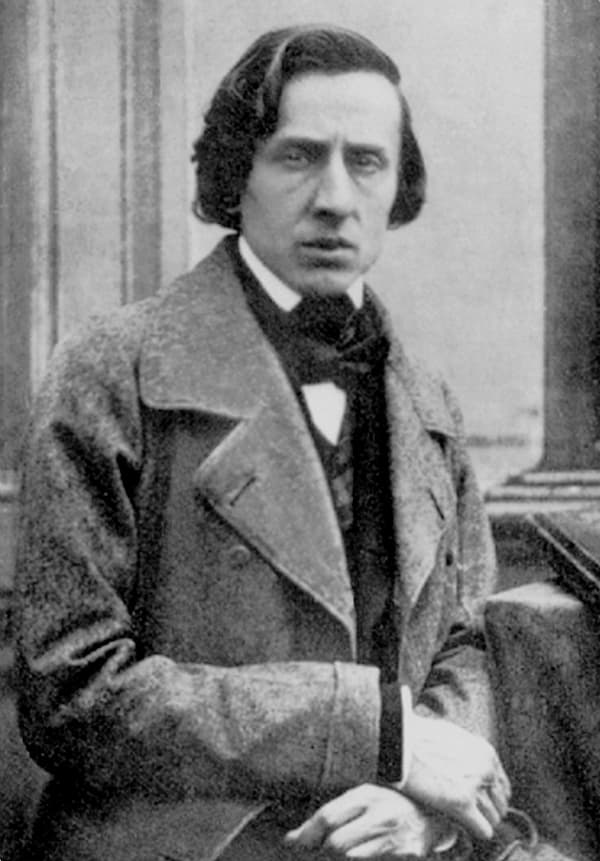
Frédéric Chopin
Benjamin Britten famously quipped, “nighttime is for sleeping,” but the eerie calm of the dark has motivated many composers, perhaps none more famously than Frédéric Chopin. Inspired by the Irishman John Field, who pioneered the nocturne style, Chopin’s creations in that genre were celebrated by his contemporaries and remain some of his most enduring works.
In simple words, a nocturne is a short character piece for piano that evokes some aspects of the night, ranging from wistful melancholy to longing. While the left hand plays broken chords as an accompaniment, the right hand articulates a vocal-styled melody. While the technical demands are generally not overwhelming, nocturnes are expressively open to the pianist.
During Chopin’s lifetime, the nocturnes were his most popular pieces. The first were written when he was seventeen, the last three years before his death. Chopin composed his three nocturnes Op. 9 between 1830 and 1832, and this first published set of Nocturnes featured some of his most universally revered music.
Frédéric Chopin: Nocturne in B Major, Op. 9, No. 3 (Meng-Chieh Liu, piano)
Nocturne in F Major, Op. 15, No. 1
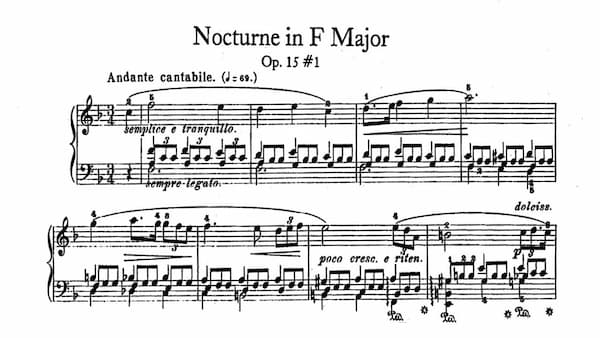
Chopin’s Nocturne Op. 15 No. 1
Op. 9 No. 3 has a ternary structure but is written in a triplet meter with a waltz-like melody that is unusual for the genre. It takes the listener along a breathtaking flight through the night sky, at times moving, frightening, and elevating. The dance shifts into a dramatic second theme, before returning to the nostalgic and light opening material.
The final “Adagio” marking in the last measures signals a feeling of profound communion with the night and the stars, and as one commentator puts it, “possibly with the whole of Creation.”
The Three Nocturnes Op. 15, published in 1833, bring back many of the poetic motives and themes of the Op. 9, but in a more philosophical and pensive character. No. 1 in F Major features one of Chopin’s most evocative melodies, supported by a strikingly original use of chromatic harmony, dissonance, and counterpoint.
Frédéric Chopin: Nocturne in F Major, Op. 15, No. 1 (Meng-Chieh Liu, piano)
Nocturne in G minor, Op. 15, No. 3
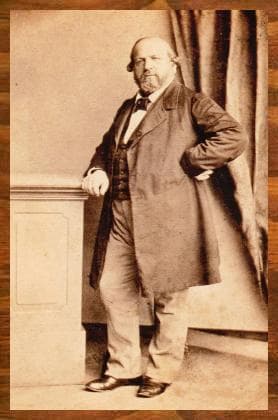
Ferdinand Hiller
In Op. 15 No. 3, cast in G minor, Chopin retreats even more inwards and drafts a delicate meditation on mortality pinned with unanswered, open-ended questions. An anecdote tells that Chopin initially inscribed this nocturne “at the Cemetery,” but he deleted the inscription while exclaiming, “Let them figure it out by themselves.”
Dedicated to Ferdinand Hiller, Chopin here breaks with the typical nocturne style. Unlike in his earlier work with arpeggiated accompaniment, the nocturne uses block chords and does not return to the initial section. Its fragmented melody, paired with chromatic transitions and minimal cadences, maintains a tender yet mysterious nighttime mood.
The first section features a thematic opening with a brief development and a subtle coda. The second section is marked “religioso,” and opens in the major key like a chorale. Extreme dynamics, irregular melodic phrasing and a prolonged high note resolve unexpectedly, and the interplay between melody and accompaniment blends religious and nocturnal elements. It is a most striking and unconventional work.
Frédéric Chopin: Nocturne in G minor, Op. 15, No. 3 (Meng-Chieh Liu, piano)
Nocturne in C-sharp minor, Op. 27, No. 1
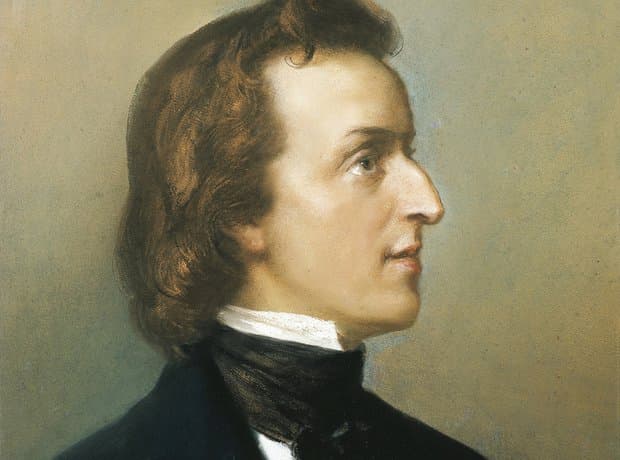
Frédéric Chopin © ClassicFM
Composed in 1836 and published in 1837, the C-sharp Minor Nocturne Op. 27 No. 1 stands as a profound testament to the composer’s evolving mastery of the nocturne form. It deliciously blends lyrical intimacy with dramatic intensity. Part of a set of two nocturnes, enharmonically related, it diverges from the stereotypical image of a nocturne as a serene, moonlit reverie.
Instead, Chopin weaves a narrative of emotional turbulence and brooding melancholy. Its structure, harmonic complexity, and expressive depth clearly distinguish it within Chopin’s oeuvre. The accompaniment patterns are wider in range, and the opening nocturne is dark, troubled, and sombre.
The opening section features a slow and mournful melody, marked by subtle chromaticism and a brief shift to the major key. Meanwhile, the central section in D-flat Major erupts into a turbulent episode with virtuosic triplets, syncopated chords, and dynamic swells, creating an intense emotional conflict. The opening theme returns with a resigned tone, still echoing the unrest of the middle section. However, it all ends with a hushed and haunting coda.
Frédéric Chopin: Nocturne in C-sharp minor, Op. 27, No. 1 (Meng-Chieh Liu, piano)
Nocturne in A-flat Major, Op. 32, No. 2
The A-flat Major Nocturne Op. 32 No. 2 was composed in 1837 and published as part of a set of two nocturnes. It exemplifies the composer’s mature command of the form, blending lyrical elegance with understated emotional depth. Dedicated to Baroness de Billing, this work adheres to the traditional nocturne archetype more closely than some of Chopin’s more experimental pieces.
This nocturne reveals Chopin’s genius through subtle harmonic sophistication, rhythmic nuance, and a refined balance of melody and accompaniment. Cast in a ternary form with a coda, it unfolds in a gentle 6/8 time, evoking the lilting sway of a barcarolle, while its A-flat major tonality imbues it with a warm, contemplative glow.
This magnificent nocturne opens with a serene Lento 6/8 accompaniment and a tender melody, subtly enriched by trills and chromaticism. The Più mosso section in F minor brings a restless, virtuosic contrast, peaking with intense triplets before calming. The opening section returns with ornate touches, all ending in a tranquil coda. Harmonically balanced and rhythmically unified, it blends peaceful elegance with a fleeting storm, showcasing Chopin’s emotive artistry.
Frédéric Chopin: Nocturne in A-flat Major, Op. 32, No. 2 (Meng-Chieh Liu, piano)
Nocturne in G minor, Op. 37, No. 1
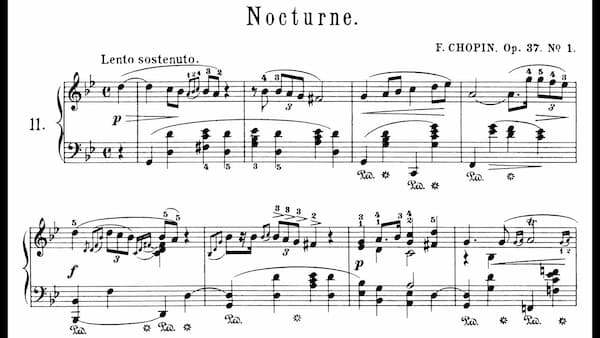
Chopin’s Nocturne Op. 37 No. 1
Composed in 1838 and published as a set of two in 1839, Op. 37 No. 1 represents a significant evolution in the composer’s approach to the nocturne form. In this opus, Chopin blends introspective melancholy with a striking structural departure from his earlier works. No. 1 features no specific dedication and it foregoes the virtuosic flourish of some earlier nocturnes.
Instead, it favours a restrained, almost austere expressiveness that unfolds in a binary form rather than the more typical ternary structure. Set in a contemplative 4/4 time and marked Andante sostenuto, its G minor tonality casts a sombre, reflective shadow, deepened by harmonic complexity and a profound interplay of thematic contrasts.
The block chords in the left hand support a restrained and mournful melody in the minor tonality. To some commentators, it evokes a mood of quiet despair. The A section subtly evolves with chromatic hints and a brief B-flat major reprieve, ending unresolved. The B section, marked religioso, shifts to E-flat major, offering a serene and chorale-like contrast with a vocal melody and rich chords peaking gently before a peaceful coda. Harmonic restraint and the thematic shift from sorrow to transcendence creates a unique and introspective nocturne.
Frédéric Chopin: Nocturne in G minor, Op. 37, No. 1 (Meng-Chieh Liu, piano)
Nocturne in F-sharp minor, Op. 48, No. 2

Chopin’s Nocturne Op. 48 No. 2
Composed in 1841 and dedicated to Laure Duperré, Op. 48 No. 2 stands as one of the composer’s most introspective and structurally sophisticated works within the nocturne genre. Written during a period of personal and physical decline, this piece eschews the overt virtuosity of some earlier nocturnes, instead embracing a profound emotional depth and a refined balance of lyricism and restraint.
Cast in a ternary form with a coda, it unfolds in a flowing 3/4 time, its F-sharp minor tonality weaving a tapestry of melancholy tinged with moments of fragile hope. The work’s harmonic richness, rhythmic subtlety, and thematic development elevate it into a poignant meditation on sorrow and fleeting serenity.
It opens with a lilting, broken-chord accompaniment and a delicate mournful melody. The A section subtly evolves with chromatic hints and a brief A major reprieve, ending unresolved. The central section shifts towards the major, offering a serene, chorale-like contrast with a broad, singing melody, peaking softly before returning to F-sharp minor. The opening theme returns with deeper resignation, followed by a haunting coda.
Frédéric Chopin: Nocturne in F-sharp minor, Op. 48, No. 2 (Meng-Chieh Liu, piano)
Nocturne in E-flat Major, Op. 55, No. 2
Frédéric Chopin’s Op. 55 No. 2 stands as a refined gem within his later output, reflecting a shift toward greater structural complexity and emotional subtlety. Written during a period of declining health and artistic introspection, this nocturne celebrates the dramatic contrasts of earlier works for a seamless, almost improvisatory flow, unfolding in a modified ternary form with a coda.
Marked Lento sostenuto and set in a gentle 4/4 time, its E-flat major tonality radiates a warm, contemplative glow, tempered by intricate counterpoint and harmonic nuance. The piece’s understated elegance and lyrical depth make it a profound exploration of serenity tinged with quiet yearning.
The flowing opening, with its wave-like accompaniment, supports a graceful and elusive melody with contrapuntal lines entering early on. This opening subtly shifts to the dominant key but ends unresolved. The minor contrast introduces a poignant sustained melody with rich counterpoint before returning to the home key. The opening returns with ornaments, and all ends in a serene coda. To be sure, its harmonic flow and thematic serenity reflect Chopin’s late, introspective style.
Frédéric Chopin: Nocturne in E-flat Major minor, Op. 55, No. 2 (Meng-Chieh Liu, piano)
Nocturne in E Major, Op. 62, No. 2
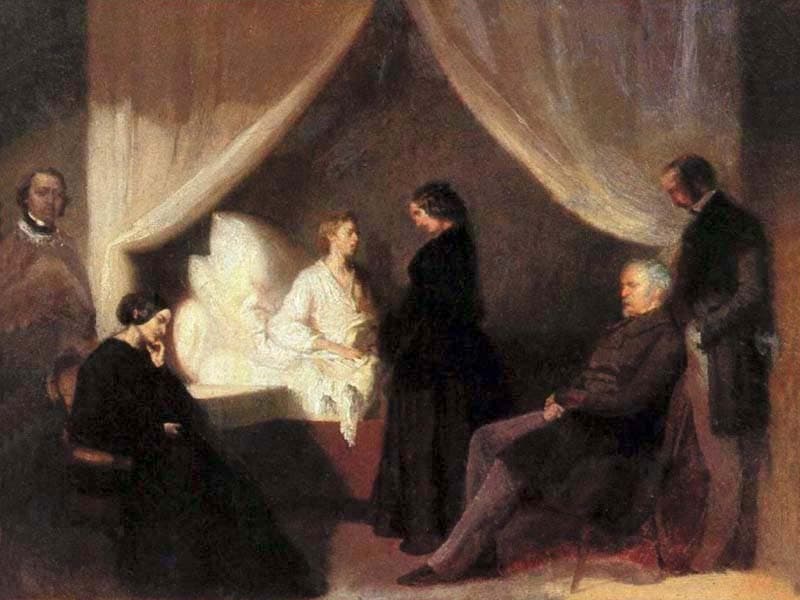
Chopin on His Deathbed, by Kwiatkowski, 1849, commissioned by Jane Stirling.
Frédéric Chopin’s Nocturne in E Major, Op. 62 No. 2, composed in 1846 and published in 1848 as part of his final pair of nocturnes dedicated to Mademoiselle R. de Konneritz, stands as one of the composer’s last works in the genre and a testament to his late stylistic maturity. Written during a period of frail health, this nocturne forgoes the youthful exuberance of earlier works for a sophisticated blend of lyricism, contrapuntal complexity, and harmonic depth. Cast in a ternary form with a coda, it unfolds in a flowing 6/8 time marked Lento, its E major tonality radiating a serene yet poignant warmth. The piece’s intricate polyphony, subtle emotional shifts, and structural elegance make it a profound capstone to Chopin’s nocturne oeuvre.
The lilting, broken-chord accompaniment supports a tender and elusive melody. The opening section briefly modulated, but ends unresolves. This tender opening is contrasted by a virtuosic and stormy melody featuring triplets, before returning to the opening key. This magnificent nocturne concludes with a serene coda, its harmonic subtlety and thematic contract reflecting Chopin’s late mastery.
Frédéric Chopin: Nocturne in E Major, Op. 62, No. 2 (Meng-Chieh Liu, piano)
Nocturne in C minor, Op. posth.
The three posthumous Nocturnes were composed at the very beginning of Chopin’s artistic career. Composed during his early maturity, most likely around 1837, it wasn’t published until after his death in 1849. We still don’t know why Chopin decided to withhold the piece, but he possibly didn’t consider it fully refined or too private for publication.
Nevertheless, it’s a gem that showcases his signature lyrical style and emotional depth. This nocturne is supremely aching and nostalgic, and many commentators read it as the composer’s swan song and a farewell to the world.
It certainly feels like a quiet lament, all borne from a simple accompaniment. The central section in the major key offers a glimmer of warmth, but quickly retreats into the melancholic embrace of the opening theme. With restrained chromaticism and a hushed, fading close, the piece whispers of introspection; it lingers as a tender echo of unspoken sorrow.
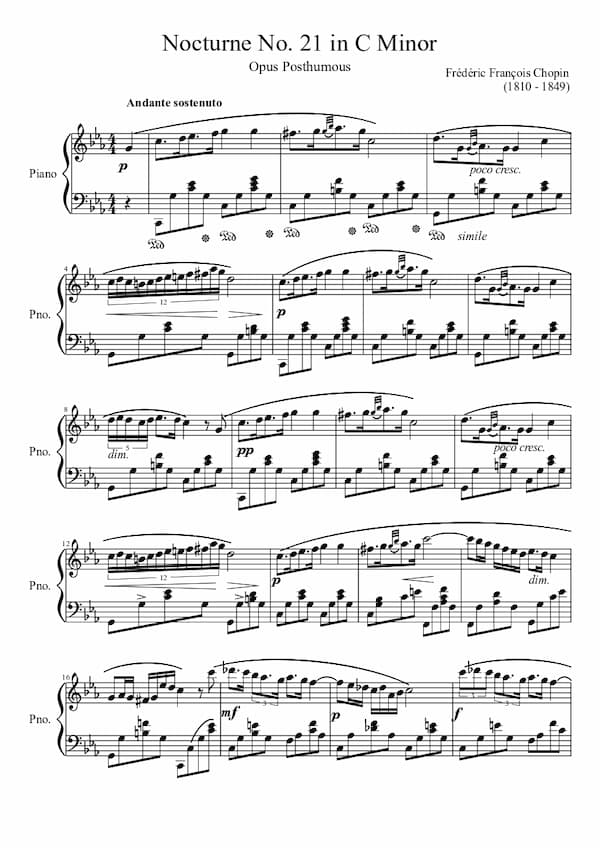
Chopin’s Nocturne in C minor, Op. posth.
Chopin’s nocturnes hold profound emotional importance as intimate musical portraits, weaving melancholy, tenderness, and fleeting joy into their lyrical melodies. Musically, they are cornerstones of Romantic piano literature, showcasing Chopin’s innovative harmonic language, delicate ornamentation, and mastery of expressive phrasing, which elevated the nocturne form into a vehicle for both technical brilliance and poetic depth.
Frédéric Chopin: Nocturne in C minor, Op. posth. (Meng-Chieh Liu, piano)
For more of the best in classical music, sign up for our E-Newsletter

